Financial Investment: Efficient Market Hypothesis - A Detailed Report
VerifiedAdded on 2022/09/25
|7
|1565
|23
Report
AI Summary
This report provides a comprehensive overview of the Efficient Market Hypothesis (EMH), a cornerstone concept in financial economics. It begins by defining the EMH, which posits that asset prices reflect all available information, and then explores its theoretical foundations, including the three forms: weak, semi-strong, and strong. The report then delves into empirical evidence supporting the EMH, citing studies that investigate the hypothesis in various stock markets, such as the Karachi Stock Exchange. It also acknowledges the challenges to the EMH, including market anomalies and behavioral finance, and discusses how these factors can impact market efficiency. The report concludes by summarizing the key aspects of the EMH, emphasizing its relevance in investment strategies and the complexities of financial markets. The report uses various sources to support its findings, including academic articles and research papers, to provide a well-rounded analysis of the topic.
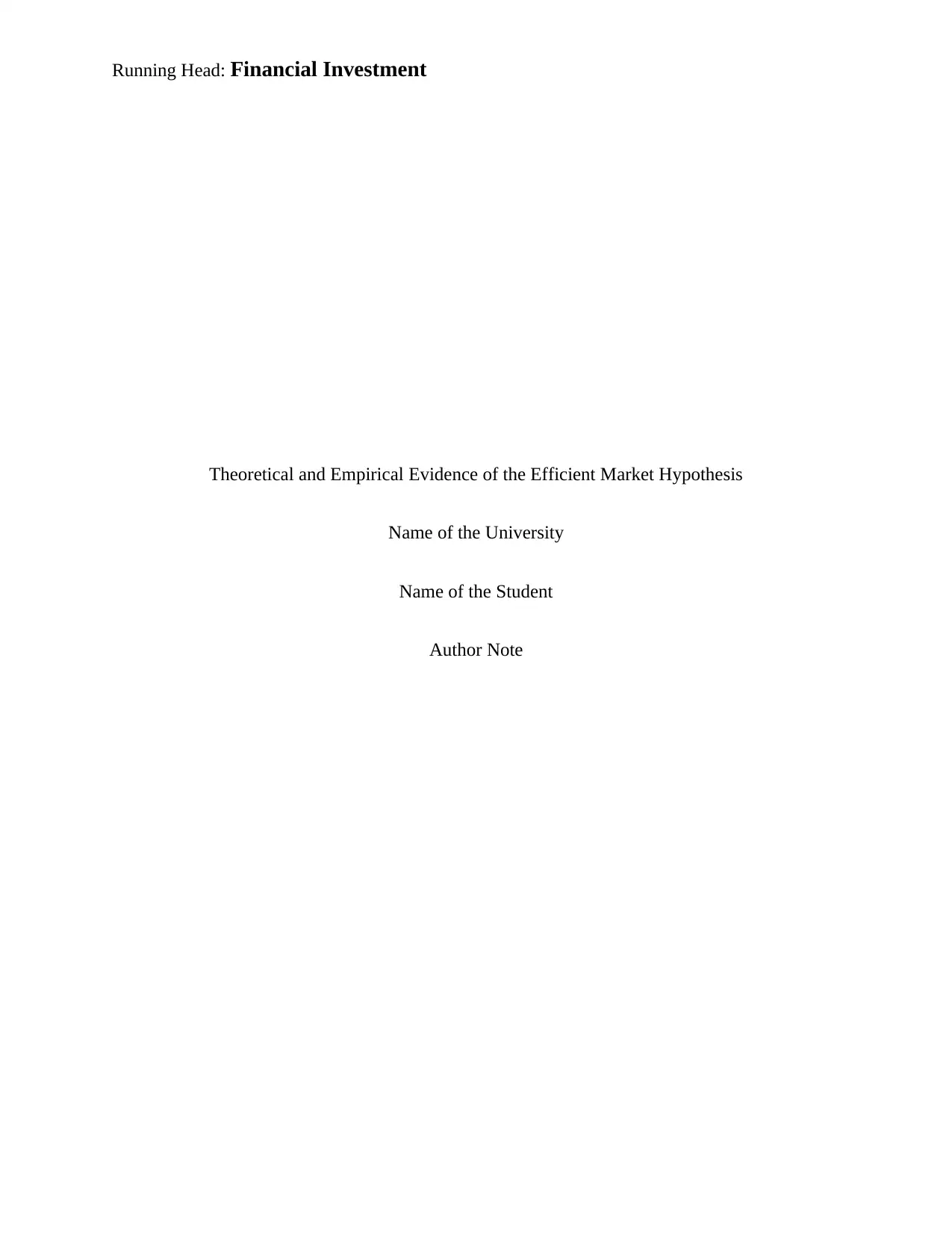
Running Head: Financial Investment
Theoretical and Empirical Evidence of the Efficient Market Hypothesis
Name of the University
Name of the Student
Author Note
Theoretical and Empirical Evidence of the Efficient Market Hypothesis
Name of the University
Name of the Student
Author Note
Paraphrase This Document
Need a fresh take? Get an instant paraphrase of this document with our AI Paraphraser
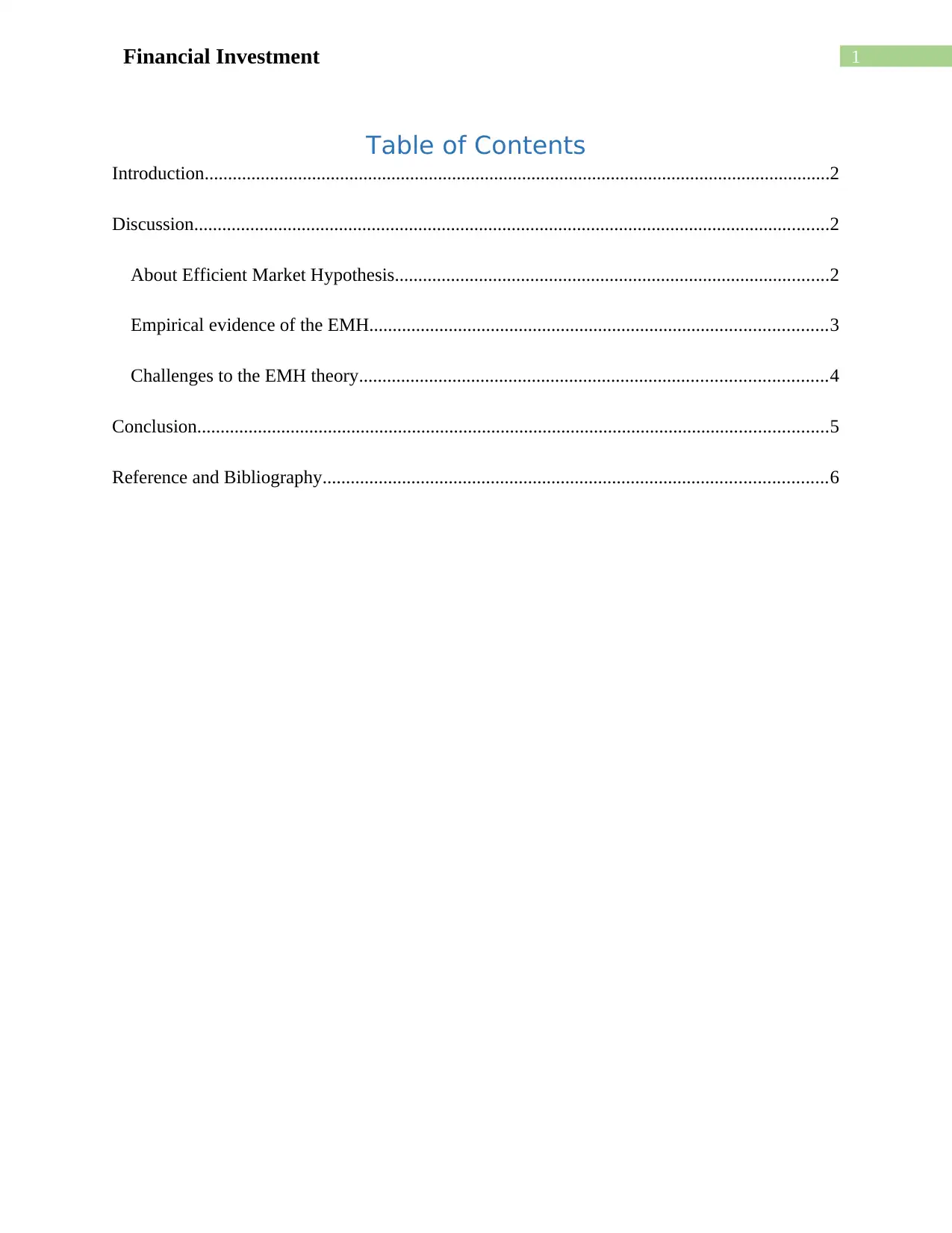
1Financial Investment
Table of Contents
Introduction......................................................................................................................................2
Discussion........................................................................................................................................2
About Efficient Market Hypothesis.............................................................................................2
Empirical evidence of the EMH..................................................................................................3
Challenges to the EMH theory....................................................................................................4
Conclusion.......................................................................................................................................5
Reference and Bibliography............................................................................................................6
Table of Contents
Introduction......................................................................................................................................2
Discussion........................................................................................................................................2
About Efficient Market Hypothesis.............................................................................................2
Empirical evidence of the EMH..................................................................................................3
Challenges to the EMH theory....................................................................................................4
Conclusion.......................................................................................................................................5
Reference and Bibliography............................................................................................................6
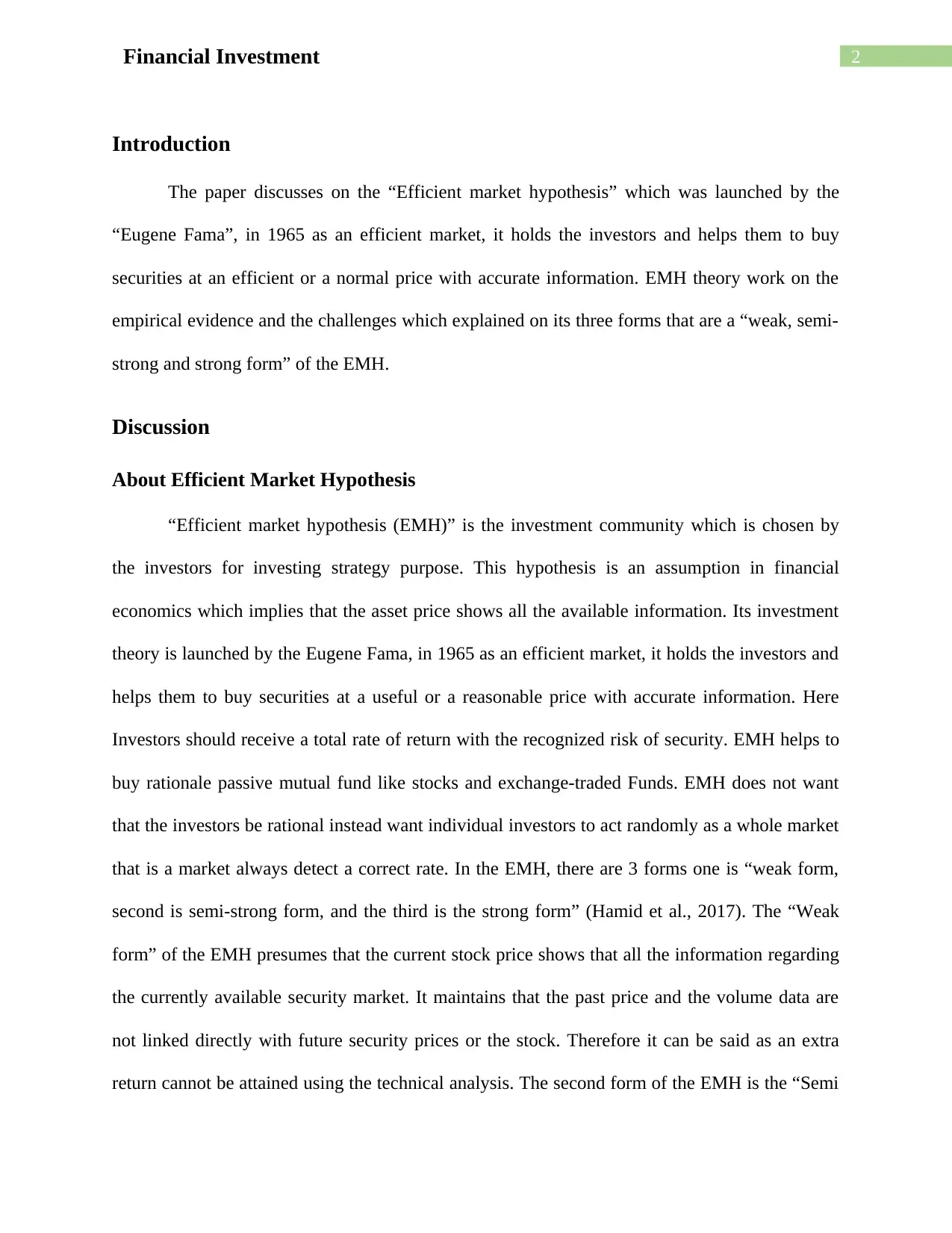
2Financial Investment
Introduction
The paper discusses on the “Efficient market hypothesis” which was launched by the
“Eugene Fama”, in 1965 as an efficient market, it holds the investors and helps them to buy
securities at an efficient or a normal price with accurate information. EMH theory work on the
empirical evidence and the challenges which explained on its three forms that are a “weak, semi-
strong and strong form” of the EMH.
Discussion
About Efficient Market Hypothesis
“Efficient market hypothesis (EMH)” is the investment community which is chosen by
the investors for investing strategy purpose. This hypothesis is an assumption in financial
economics which implies that the asset price shows all the available information. Its investment
theory is launched by the Eugene Fama, in 1965 as an efficient market, it holds the investors and
helps them to buy securities at a useful or a reasonable price with accurate information. Here
Investors should receive a total rate of return with the recognized risk of security. EMH helps to
buy rationale passive mutual fund like stocks and exchange-traded Funds. EMH does not want
that the investors be rational instead want individual investors to act randomly as a whole market
that is a market always detect a correct rate. In the EMH, there are 3 forms one is “weak form,
second is semi-strong form, and the third is the strong form” (Hamid et al., 2017). The “Weak
form” of the EMH presumes that the current stock price shows that all the information regarding
the currently available security market. It maintains that the past price and the volume data are
not linked directly with future security prices or the stock. Therefore it can be said as an extra
return cannot be attained using the technical analysis. The second form of the EMH is the “Semi
Introduction
The paper discusses on the “Efficient market hypothesis” which was launched by the
“Eugene Fama”, in 1965 as an efficient market, it holds the investors and helps them to buy
securities at an efficient or a normal price with accurate information. EMH theory work on the
empirical evidence and the challenges which explained on its three forms that are a “weak, semi-
strong and strong form” of the EMH.
Discussion
About Efficient Market Hypothesis
“Efficient market hypothesis (EMH)” is the investment community which is chosen by
the investors for investing strategy purpose. This hypothesis is an assumption in financial
economics which implies that the asset price shows all the available information. Its investment
theory is launched by the Eugene Fama, in 1965 as an efficient market, it holds the investors and
helps them to buy securities at a useful or a reasonable price with accurate information. Here
Investors should receive a total rate of return with the recognized risk of security. EMH helps to
buy rationale passive mutual fund like stocks and exchange-traded Funds. EMH does not want
that the investors be rational instead want individual investors to act randomly as a whole market
that is a market always detect a correct rate. In the EMH, there are 3 forms one is “weak form,
second is semi-strong form, and the third is the strong form” (Hamid et al., 2017). The “Weak
form” of the EMH presumes that the current stock price shows that all the information regarding
the currently available security market. It maintains that the past price and the volume data are
not linked directly with future security prices or the stock. Therefore it can be said as an extra
return cannot be attained using the technical analysis. The second form of the EMH is the “Semi
⊘ This is a preview!⊘
Do you want full access?
Subscribe today to unlock all pages.

Trusted by 1+ million students worldwide
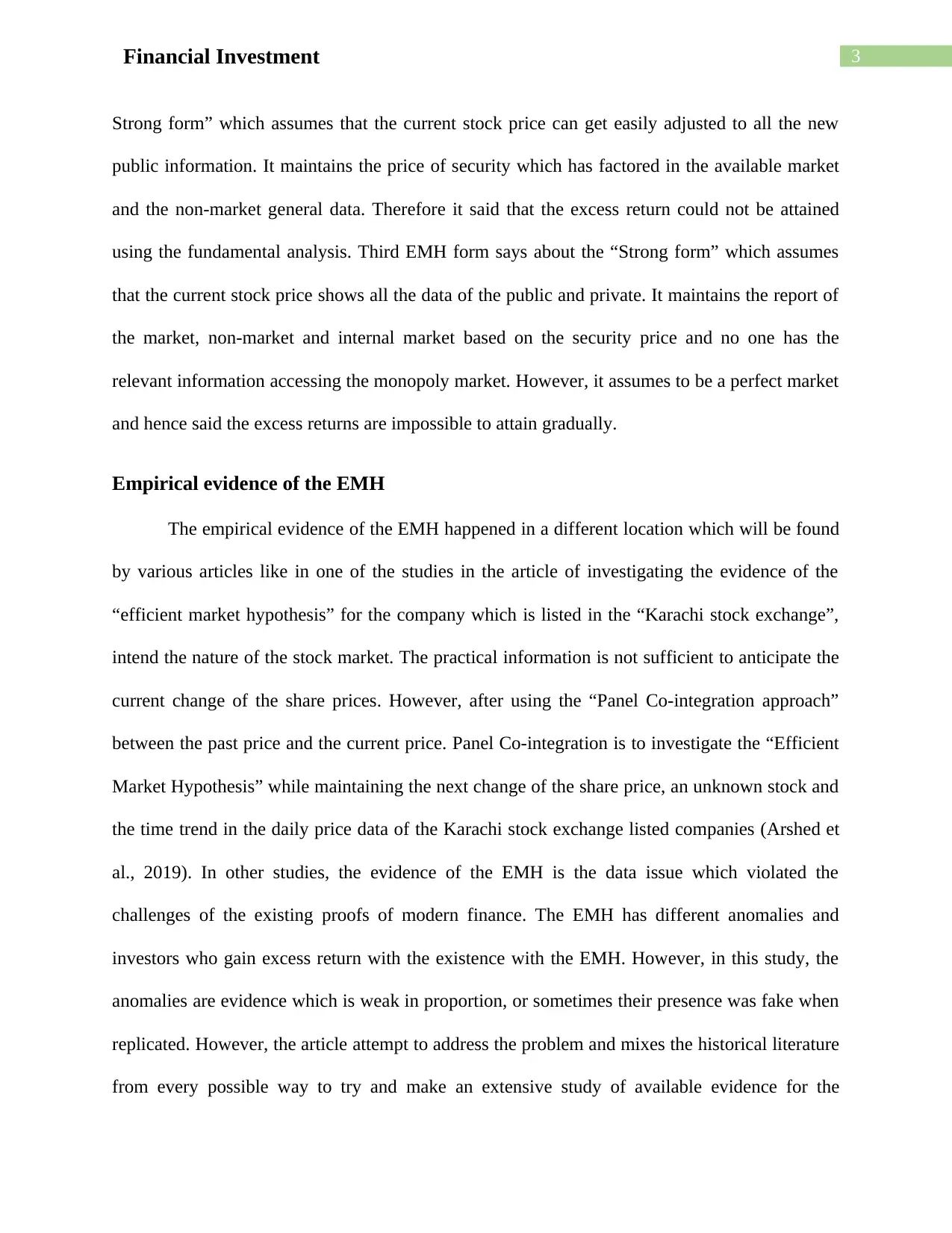
3Financial Investment
Strong form” which assumes that the current stock price can get easily adjusted to all the new
public information. It maintains the price of security which has factored in the available market
and the non-market general data. Therefore it said that the excess return could not be attained
using the fundamental analysis. Third EMH form says about the “Strong form” which assumes
that the current stock price shows all the data of the public and private. It maintains the report of
the market, non-market and internal market based on the security price and no one has the
relevant information accessing the monopoly market. However, it assumes to be a perfect market
and hence said the excess returns are impossible to attain gradually.
Empirical evidence of the EMH
The empirical evidence of the EMH happened in a different location which will be found
by various articles like in one of the studies in the article of investigating the evidence of the
“efficient market hypothesis” for the company which is listed in the “Karachi stock exchange”,
intend the nature of the stock market. The practical information is not sufficient to anticipate the
current change of the share prices. However, after using the “Panel Co-integration approach”
between the past price and the current price. Panel Co-integration is to investigate the “Efficient
Market Hypothesis” while maintaining the next change of the share price, an unknown stock and
the time trend in the daily price data of the Karachi stock exchange listed companies (Arshed et
al., 2019). In other studies, the evidence of the EMH is the data issue which violated the
challenges of the existing proofs of modern finance. The EMH has different anomalies and
investors who gain excess return with the existence with the EMH. However, in this study, the
anomalies are evidence which is weak in proportion, or sometimes their presence was fake when
replicated. However, the article attempt to address the problem and mixes the historical literature
from every possible way to try and make an extensive study of available evidence for the
Strong form” which assumes that the current stock price can get easily adjusted to all the new
public information. It maintains the price of security which has factored in the available market
and the non-market general data. Therefore it said that the excess return could not be attained
using the fundamental analysis. Third EMH form says about the “Strong form” which assumes
that the current stock price shows all the data of the public and private. It maintains the report of
the market, non-market and internal market based on the security price and no one has the
relevant information accessing the monopoly market. However, it assumes to be a perfect market
and hence said the excess returns are impossible to attain gradually.
Empirical evidence of the EMH
The empirical evidence of the EMH happened in a different location which will be found
by various articles like in one of the studies in the article of investigating the evidence of the
“efficient market hypothesis” for the company which is listed in the “Karachi stock exchange”,
intend the nature of the stock market. The practical information is not sufficient to anticipate the
current change of the share prices. However, after using the “Panel Co-integration approach”
between the past price and the current price. Panel Co-integration is to investigate the “Efficient
Market Hypothesis” while maintaining the next change of the share price, an unknown stock and
the time trend in the daily price data of the Karachi stock exchange listed companies (Arshed et
al., 2019). In other studies, the evidence of the EMH is the data issue which violated the
challenges of the existing proofs of modern finance. The EMH has different anomalies and
investors who gain excess return with the existence with the EMH. However, in this study, the
anomalies are evidence which is weak in proportion, or sometimes their presence was fake when
replicated. However, the article attempt to address the problem and mixes the historical literature
from every possible way to try and make an extensive study of available evidence for the
Paraphrase This Document
Need a fresh take? Get an instant paraphrase of this document with our AI Paraphraser
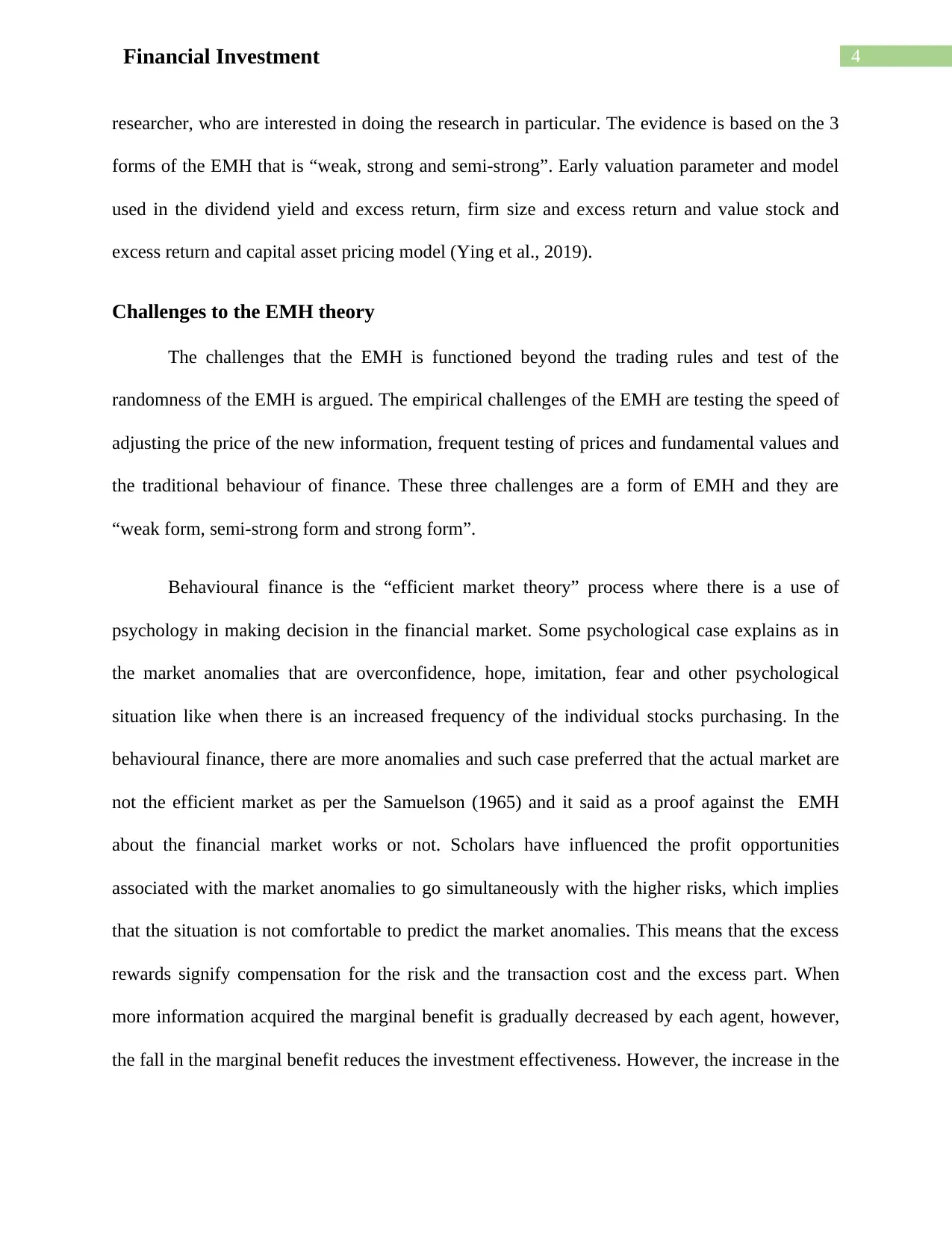
4Financial Investment
researcher, who are interested in doing the research in particular. The evidence is based on the 3
forms of the EMH that is “weak, strong and semi-strong”. Early valuation parameter and model
used in the dividend yield and excess return, firm size and excess return and value stock and
excess return and capital asset pricing model (Ying et al., 2019).
Challenges to the EMH theory
The challenges that the EMH is functioned beyond the trading rules and test of the
randomness of the EMH is argued. The empirical challenges of the EMH are testing the speed of
adjusting the price of the new information, frequent testing of prices and fundamental values and
the traditional behaviour of finance. These three challenges are a form of EMH and they are
“weak form, semi-strong form and strong form”.
Behavioural finance is the “efficient market theory” process where there is a use of
psychology in making decision in the financial market. Some psychological case explains as in
the market anomalies that are overconfidence, hope, imitation, fear and other psychological
situation like when there is an increased frequency of the individual stocks purchasing. In the
behavioural finance, there are more anomalies and such case preferred that the actual market are
not the efficient market as per the Samuelson (1965) and it said as a proof against the EMH
about the financial market works or not. Scholars have influenced the profit opportunities
associated with the market anomalies to go simultaneously with the higher risks, which implies
that the situation is not comfortable to predict the market anomalies. This means that the excess
rewards signify compensation for the risk and the transaction cost and the excess part. When
more information acquired the marginal benefit is gradually decreased by each agent, however,
the fall in the marginal benefit reduces the investment effectiveness. However, the increase in the
researcher, who are interested in doing the research in particular. The evidence is based on the 3
forms of the EMH that is “weak, strong and semi-strong”. Early valuation parameter and model
used in the dividend yield and excess return, firm size and excess return and value stock and
excess return and capital asset pricing model (Ying et al., 2019).
Challenges to the EMH theory
The challenges that the EMH is functioned beyond the trading rules and test of the
randomness of the EMH is argued. The empirical challenges of the EMH are testing the speed of
adjusting the price of the new information, frequent testing of prices and fundamental values and
the traditional behaviour of finance. These three challenges are a form of EMH and they are
“weak form, semi-strong form and strong form”.
Behavioural finance is the “efficient market theory” process where there is a use of
psychology in making decision in the financial market. Some psychological case explains as in
the market anomalies that are overconfidence, hope, imitation, fear and other psychological
situation like when there is an increased frequency of the individual stocks purchasing. In the
behavioural finance, there are more anomalies and such case preferred that the actual market are
not the efficient market as per the Samuelson (1965) and it said as a proof against the EMH
about the financial market works or not. Scholars have influenced the profit opportunities
associated with the market anomalies to go simultaneously with the higher risks, which implies
that the situation is not comfortable to predict the market anomalies. This means that the excess
rewards signify compensation for the risk and the transaction cost and the excess part. When
more information acquired the marginal benefit is gradually decreased by each agent, however,
the fall in the marginal benefit reduces the investment effectiveness. However, the increase in the

5Financial Investment
number of agents in acquiring the investment does not lead to higher market efficiency. Thus
there is no equilibrium in the model (Alajbeg, Bubas, & Sonje, 2012).
Conclusion
It can be concluded that the “Efficient market hypothesis” is the assumption in the
financial economics which implies that the asset price provides all the relevant details along with
the three forms that are “weak form, semi-strong form and strong form” with the EMH helps to
maintain the data of the market, non-market and internal market based on the security price and
no one has the relevant information accessing the monopoly market. The empirical evidence of
the EMH shows investigating the evidence of the “efficient market hypothesis” of the company
related to the stock market and using the “Panel Co-integration approach” between the past price
and the current price record. The challenges of the EMH is also based on the three forms
however the challenge is related to the behavioural finance which is the strong form of the EMH
number of agents in acquiring the investment does not lead to higher market efficiency. Thus
there is no equilibrium in the model (Alajbeg, Bubas, & Sonje, 2012).
Conclusion
It can be concluded that the “Efficient market hypothesis” is the assumption in the
financial economics which implies that the asset price provides all the relevant details along with
the three forms that are “weak form, semi-strong form and strong form” with the EMH helps to
maintain the data of the market, non-market and internal market based on the security price and
no one has the relevant information accessing the monopoly market. The empirical evidence of
the EMH shows investigating the evidence of the “efficient market hypothesis” of the company
related to the stock market and using the “Panel Co-integration approach” between the past price
and the current price record. The challenges of the EMH is also based on the three forms
however the challenge is related to the behavioural finance which is the strong form of the EMH
⊘ This is a preview!⊘
Do you want full access?
Subscribe today to unlock all pages.

Trusted by 1+ million students worldwide
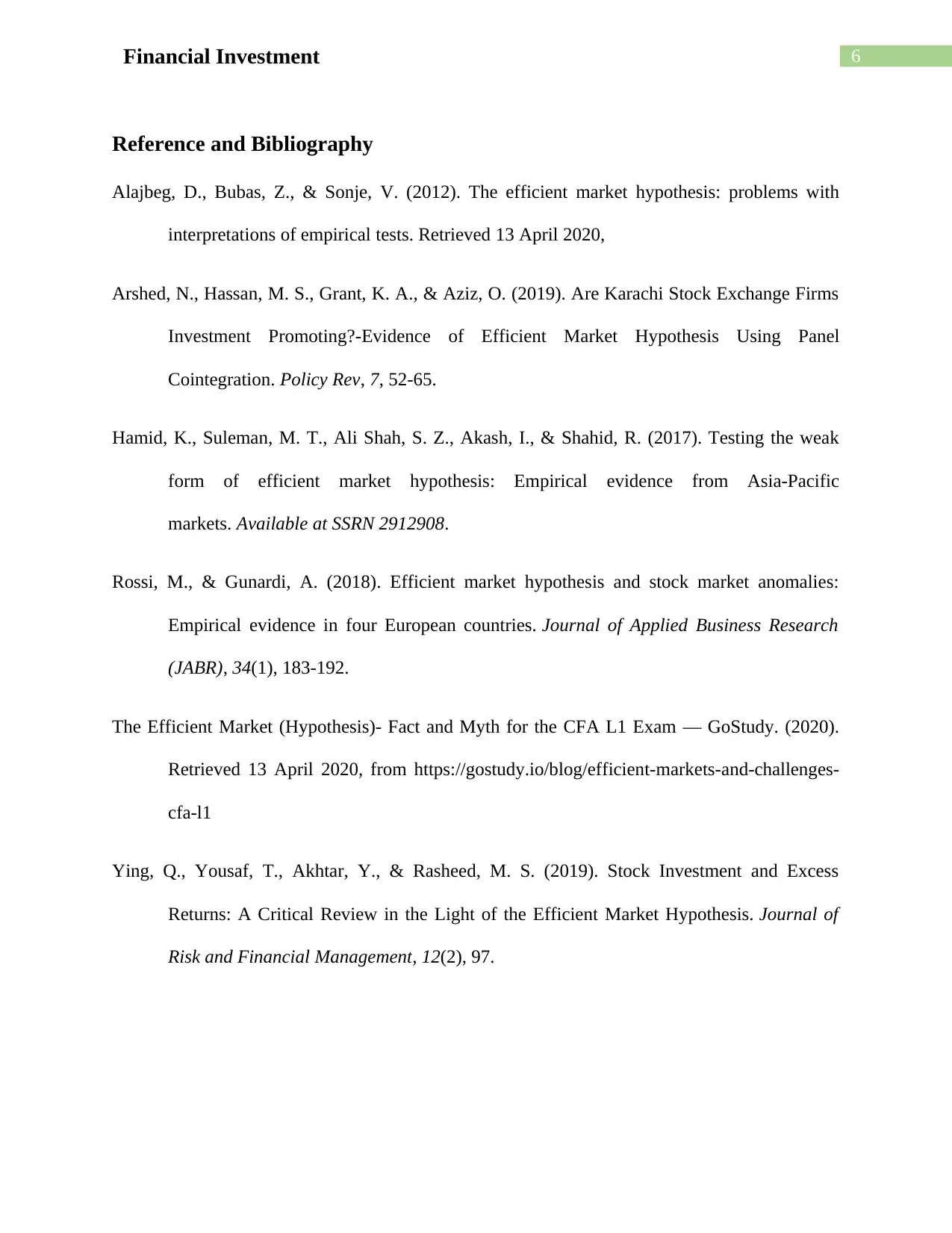
6Financial Investment
Reference and Bibliography
Alajbeg, D., Bubas, Z., & Sonje, V. (2012). The efficient market hypothesis: problems with
interpretations of empirical tests. Retrieved 13 April 2020,
Arshed, N., Hassan, M. S., Grant, K. A., & Aziz, O. (2019). Are Karachi Stock Exchange Firms
Investment Promoting?-Evidence of Efficient Market Hypothesis Using Panel
Cointegration. Policy Rev, 7, 52-65.
Hamid, K., Suleman, M. T., Ali Shah, S. Z., Akash, I., & Shahid, R. (2017). Testing the weak
form of efficient market hypothesis: Empirical evidence from Asia-Pacific
markets. Available at SSRN 2912908.
Rossi, M., & Gunardi, A. (2018). Efficient market hypothesis and stock market anomalies:
Empirical evidence in four European countries. Journal of Applied Business Research
(JABR), 34(1), 183-192.
The Efficient Market (Hypothesis)- Fact and Myth for the CFA L1 Exam — GoStudy. (2020).
Retrieved 13 April 2020, from https://gostudy.io/blog/efficient-markets-and-challenges-
cfa-l1
Ying, Q., Yousaf, T., Akhtar, Y., & Rasheed, M. S. (2019). Stock Investment and Excess
Returns: A Critical Review in the Light of the Efficient Market Hypothesis. Journal of
Risk and Financial Management, 12(2), 97.
Reference and Bibliography
Alajbeg, D., Bubas, Z., & Sonje, V. (2012). The efficient market hypothesis: problems with
interpretations of empirical tests. Retrieved 13 April 2020,
Arshed, N., Hassan, M. S., Grant, K. A., & Aziz, O. (2019). Are Karachi Stock Exchange Firms
Investment Promoting?-Evidence of Efficient Market Hypothesis Using Panel
Cointegration. Policy Rev, 7, 52-65.
Hamid, K., Suleman, M. T., Ali Shah, S. Z., Akash, I., & Shahid, R. (2017). Testing the weak
form of efficient market hypothesis: Empirical evidence from Asia-Pacific
markets. Available at SSRN 2912908.
Rossi, M., & Gunardi, A. (2018). Efficient market hypothesis and stock market anomalies:
Empirical evidence in four European countries. Journal of Applied Business Research
(JABR), 34(1), 183-192.
The Efficient Market (Hypothesis)- Fact and Myth for the CFA L1 Exam — GoStudy. (2020).
Retrieved 13 April 2020, from https://gostudy.io/blog/efficient-markets-and-challenges-
cfa-l1
Ying, Q., Yousaf, T., Akhtar, Y., & Rasheed, M. S. (2019). Stock Investment and Excess
Returns: A Critical Review in the Light of the Efficient Market Hypothesis. Journal of
Risk and Financial Management, 12(2), 97.
1 out of 7
Related Documents
Your All-in-One AI-Powered Toolkit for Academic Success.
+13062052269
info@desklib.com
Available 24*7 on WhatsApp / Email
![[object Object]](/_next/static/media/star-bottom.7253800d.svg)
Unlock your academic potential
Copyright © 2020–2025 A2Z Services. All Rights Reserved. Developed and managed by ZUCOL.





